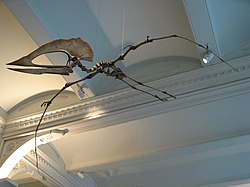
Back Tupuxuara Catalan Tupuxuara Czech Tupuxuara German Tupuxuara Spanish Tupuxuara French טופוקסוארה HE Tupuxuara Croatian Tupuxuara Italian トゥプクスアラ Japanese Tupuxuara Dutch
| Tupuxuara Temporal range: Albian,
| |
|---|---|

| |
| Reconstructed skeleton of T. leonardii, American Museum of Natural History | |
| Scientific classification | |
| Domain: | Eukaryota |
| Kingdom: | Animalia |
| Phylum: | Chordata |
| Order: | †Pterosauria |
| Suborder: | †Pterodactyloidea |
| Family: | †Thalassodromidae |
| Genus: | †Tupuxuara Kellner & Campos, 1988 |
| Type species | |
| †Tupuxuara longicristatus Kellner & Campos, 1988
| |
| Other species | |
| |
Tupuxuara is a genus of thalassodromid pterosaur that lived during the Albian age of the Early Cretaceous, about 112 million years ago. Its remains were found in what is now the Romualdo Formation of the Santana Group in Brazil. Tupuxuara was named in 1988 by paleontologists Alexander Kellner and Diógenes de Almeida Campos. The name Tupuxuara means "familiar spirit" referring to a familiar spirit in the mythology of the Tupi people in Brazil. Two species have been named, T. longicristatus, the type species, and T. leonardii. An additional species has been named in 2013, T. deliradamus. However, the validity of this species has been put into question and it may not even belong to Tupuxuara.
Tupuxuara was quite large in size. It had a big crest at the back portion of its head, stemming from the snout. This crest is most likely an indicator of sexual maturity, given that it appears more prominently in mature individuals. The beak of Tupuxuara was toothless. A wingspan of 4.7 m (15 ft) and a body mass of 25 kg (55 lb) have been estimated for Tupuxuara, indicating that it had long wings with respect to its mass.
The classification history of Tupuxuara has been quite controversial. It was initially assigned to the family Tapejaridae, grouped with the closely related Thalassodromeus in a subfamily called Thalassodrominae. However, several studies have argued against this arrangement and have supported a closer relationship with the families Azhdarchidae and Dsungaripteridae, with Thalassodrominae being elevated to family level, thus creating the term Thalassodromidae. All three families would be grouped in a clade called Neoazhdarchia. More recently, studies that support a tapejarid identity for Tupuxuara have also favored the denomination Thalassodromidae to have consistency, which would effectively remove the group from Tapejaridae. Nonetheless, they would find thalassodromids and tapejarids to group together in a clade called Tapejaromorpha. Early studies had suggested that Tupuxuara was piscivorous (a fish eater), with some even suggesting a fruit-based diet. However, based on its azhdarchoid lineage, Tupuxuara most likely would have been a terrestrial omnivore or carnivore.